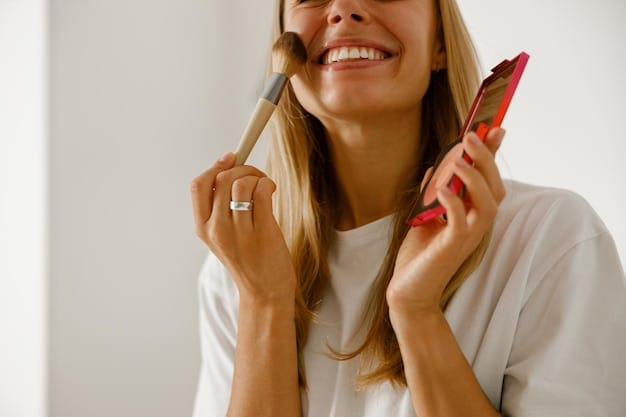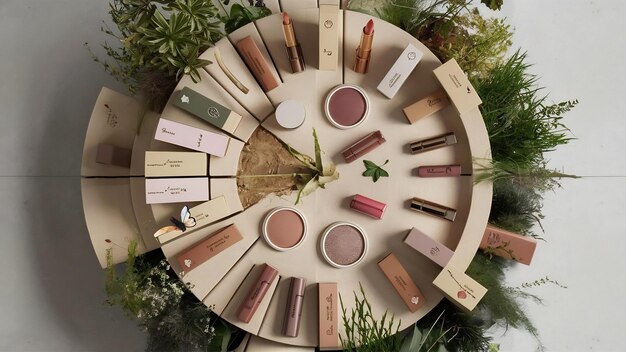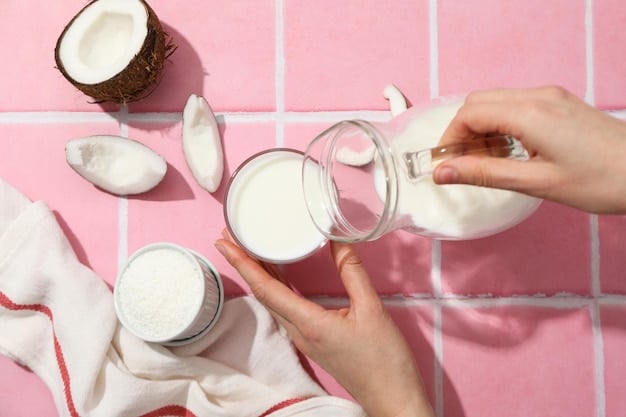The 2025 Guide to Sustainable Makeup: Eco-Friendly Beauty and Application

The 2025 Guide to Sustainable Makeup: Eco-Friendly Products and Application Techniques explores the rising demand for environmentally conscious beauty options, offering insights into sustainable product choices, ethical sourcing, and innovative application methods that minimize waste and promote a healthier planet.
Navigating the world of beauty in 2025 means embracing sustainability like never before. The 2025 Guide to Sustainable Makeup: Eco-Friendly Products and Application Techniques is your comprehensive resource for making informed choices that benefit both your skin and the environment.
Understanding the Rise of Sustainable Beauty
The beauty industry is undergoing a significant transformation, driven by increasing consumer awareness of environmental issues. Understanding this shift is crucial for navigating the market and making responsible purchasing decisions.
What is Sustainable Beauty?
Sustainable beauty refers to beauty products and practices that minimize negative impacts on the environment and society. This includes using eco-friendly ingredients, reducing packaging waste, and ensuring ethical labor practices.
Consumers are increasingly demanding transparency and accountability from beauty brands. They want to know where ingredients come from, how products are manufactured, and what the company is doing to reduce its carbon footprint.
The Environmental Impact of Traditional Makeup
Traditional makeup products often contain harmful chemicals and are packaged in non-recyclable materials. This contributes to pollution, resource depletion, and habitat destruction.
- Plastic Packaging: Most makeup comes in plastic packaging, which ends up in landfills or oceans.
- Harmful Chemicals: Many products contain chemicals like parabens, phthalates, and synthetic fragrances that can harm both the environment and human health.
- Resource Depletion: The extraction of raw materials for makeup production can lead to deforestation and water pollution.
Choosing sustainable alternatives can significantly reduce your environmental impact and promote a healthier planet.
In summary, understanding the rise of sustainable beauty involves recognizing the environmental impact of traditional makeup and embracing eco-friendly alternatives that prioritize both personal well-being and planetary health.

Choosing Eco-Friendly Makeup Products
Selecting the right products is key to a sustainable makeup routine. This involves understanding ingredient lists, certifications, and packaging options.
Key Ingredients to Look For
Opt for makeup products that contain natural, organic, and ethically sourced ingredients. Avoid products with synthetic fragrances, parabens, and other harmful chemicals.
Look for ingredients like:
- Organic plant oils and butters: These provide hydration and nourishment without harming the environment.
- Mineral pigments: These offer natural color without the use of synthetic dyes.
- Plant-based preservatives: These extend the shelf life of products without releasing harmful chemicals.
Understanding Certifications and Labels
Certifications provide assurance that a product meets certain environmental and ethical standards. Look for labels like:
- Certified Organic: Guarantees that the product contains organic ingredients grown without synthetic pesticides or fertilizers.
- Cruelty-Free: Indicates that the product has not been tested on animals.
- Fair Trade: Ensures that workers involved in the production of ingredients are paid fair wages and work in safe conditions.
Sustainable Packaging Options
Choose products with minimal packaging or packaging made from recycled, recyclable, or biodegradable materials. Refillable options are also a great way to reduce waste.
Brands are increasingly offering sustainable packaging solutions, such as:
- Glass or aluminum containers: These are easily recyclable and can be reused.
- Biodegradable packaging: Made from plant-based materials that decompose naturally.
- Refillable compacts and containers: Allow you to purchase refills instead of buying a new product each time.
Choosing eco-friendly makeup products involves carefully selecting ingredients, understanding certifications, and opting for sustainable packaging solutions that minimize waste and promote environmental responsibility.
Mastering Sustainable Makeup Application Techniques
Sustainable beauty isn’t just about the products you choose; it’s also about how you use them. Adopting mindful application techniques can reduce waste and enhance your overall beauty routine.
Using Reusable Makeup Tools
Switch to reusable makeup brushes, sponges, and applicators. Clean them regularly to prolong their lifespan and prevent bacterial growth.
Consider investing in:
- Bamboo-handled brushes: These are biodegradable and made from a renewable resource.
- Reusable makeup sponges: These can be washed and reused multiple times, reducing the need for disposable sponges.
- Metal or glass applicators: These are durable and can be sanitized easily.
Minimizing Product Waste
Avoid using more product than necessary. Apply makeup sparingly and build up coverage as needed. Store products properly to prevent them from drying out or expiring prematurely.
Tips for reducing product waste include:
- Using a spatula to scrape out every last bit of product from containers.
- Storing makeup in a cool, dry place to prevent it from spoiling.
- Repurposing old makeup containers for storage or DIY projects.
DIY Makeup Removal
Instead of using disposable makeup wipes, opt for reusable cotton pads or cloths soaked in natural oils or micellar water. These are gentle on your skin and better for the environment.
Effective DIY makeup removal options include:
- Coconut oil: Gently melts away makeup without harsh scrubbing.
- Micellar water: A gentle cleanser that removes makeup and impurities without rinsing.
- Reusable cotton pads: Can be washed and reused, reducing waste.
Mastering sustainable makeup application techniques involves using reusable tools, minimizing product waste, and opting for DIY makeup removal methods that promote both environmental responsibility and healthy skin.

Embracing Zero-Waste Makeup Practices
Zero-waste makeup practices aim to eliminate waste entirely by focusing on reusable, refillable, and compostable products and packaging.
Refillable Makeup Systems
Many brands now offer refillable makeup systems, allowing you to purchase refills for your favorite products instead of buying a new container each time. This significantly reduces plastic waste.
Benefits of refillable makeup systems include:
- Reduced packaging waste
- Cost savings over time
- Support for sustainable brands
Compostable Packaging Options
Look for makeup products that come in compostable packaging, such as cardboard or plant-based materials. These can be composted at home or in industrial composting facilities.
Examples of compostable packaging include:
- Seed paper packaging that can be planted after use
- Mushroom packaging made from mycelium
- Bamboo packaging that is biodegradable
DIY Makeup Alternatives
Consider making your own makeup using natural ingredients. This allows you to control what goes into your products and reduce your reliance on commercially produced cosmetics.
DIY Makeup Recipes
Creating your own makeup can be a fun and sustainable alternative to buying commercially produced products. Here are a few simple recipes to get you started:
- DIY Lip Balm: Combine equal parts beeswax, coconut oil, and shea butter. Melt the ingredients together and pour into a small container to solidify.
- DIY Blush: Mix beetroot powder with arrowroot powder to create a natural blush. Adjust the ratio to achieve your desired color.
- DIY Eyeshadow: Combine a mineral pigment with cornstarch to create custom eyeshadow colors.
Embracing zero-waste makeup practices involves using refillable systems, choosing compostable packaging, and exploring DIY makeup alternatives to eliminate waste and promote a more sustainable beauty routine.
Navigating Greenwashing in the Beauty Industry
Greenwashing is the practice of making false or misleading claims about the environmental benefits of a product or company. It’s important to be aware of greenwashing tactics and learn how to identify them.
What is Greenwashing?
Greenwashing misleads consumers into believing that a product or company is more environmentally friendly than it actually is. This can involve using vague language, exaggerating claims, or focusing on a single environmental benefit while ignoring other negative impacts.
How to Spot Greenwashing Tactics
Look beyond marketing claims and examine the actual ingredients, packaging, and manufacturing processes.
Watch out for:
- Vague language: Terms like “natural” or “eco-friendly” without clear definitions can be misleading.
- Irrelevant claims: Highlighting a single environmental benefit while ignoring other negative impacts.
- False labels: Using fake certifications or labels to deceive consumers.
Researching Brands and Products
Do your research before buying a product. Look for independent certifications, read reviews from trusted sources, and check the company’s website for detailed information about their sustainability practices.
Resources for researching brands and products include:
- EWG’s Skin Deep Database: Provides safety ratings for thousands of cosmetic ingredients.
- B Corp Certification: Indicates that a company meets high standards of social and environmental performance.
- Credible environmental organizations: Often provide guides and reports on sustainable products.
Navigating greenwashing in the beauty industry requires vigilance and a commitment to researching brands and products. By being informed and critical consumers, we can support truly sustainable companies and avoid being misled by false claims.
The Future of Sustainable Makeup in 2025 and Beyond
The future of sustainable makeup looks promising, with advancements in technology, materials, and consumer awareness driving innovation and change.
Technological Innovations
New technologies are enabling the development of more sustainable makeup products and packaging. This includes:
- Biotechnology: Using microorganisms to produce sustainable ingredients.
- 3D printing: Creating custom makeup products on demand, reducing waste and transportation emissions.
- Smart packaging: Using sensors to track product usage and provide personalized recommendations.
The Role of Consumers
Consumer demand is a powerful driver of change in the beauty industry. By choosing sustainable products and supporting eco-friendly brands, consumers can encourage companies to adopt more responsible practices.
Here are ways consumers can contribute
- Support brands with clear sustainability goals.
- Participate in recycling programs.
- spread awareness
The Role of Social Media
Social media platforms have become key tools for raising awareness about sustainable beauty. Influencers and activists use these platforms to educate consumers, promote ethical brands, and hold companies accountable.
The rise of social media
- Facilitates the sharing of information
- Allows for connection to like-minded people
- Encourages transparency
The future of sustainable makeup in 2025 and beyond is driven by technological innovations, consumer demand, and the power of social media to raise awareness and promote change.
| Key Point | Brief Description |
|---|---|
| 🌱 Eco-Friendly Ingredients | Opt for natural, organic, and ethically sourced ingredients. |
| ♻️ Sustainable Packaging | Choose minimal, recycled, recyclable, or biodegradable packaging. |
| 🖌️ Reusable Tools | Use bamboo brushes and reusable sponges to minimize waste. |
| 💧 DIY Removal | Use natural oils or micellar water with reusable cotton pads. |
Frequently Asked Questions About Sustainable Makeup
▼
Sustainable makeup uses eco-friendly ingredients, minimal and recyclable packaging, and ethical production practices to minimize environmental impact.
▼
Look for vague language, irrelevant claims, or unsubstantiated certifications. Research ingredients and certifications before purchasing.
▼
Examples: organic plant oils, mineral pigments, and plant-based preservatives. Avoid synthetic fragrances, parabens, and phthalates.
▼
You can reduce makeup waste by using refillable products, purchasing package-free options, and maximizing usage to minimize the end product left behind
▼
Sustainable makeup products can be affordable. Look for smaller companies in the marketplace that are sustainable and offer a cheaper option.
Conclusion
Embracing sustainable makeup in 2025 is not just a trend; it’s a necessary step towards a more responsible and environmentally conscious lifestyle. By making informed choices about the products we use and the practices we adopt, we can contribute to a healthier planet and a more sustainable future for the beauty industry.





